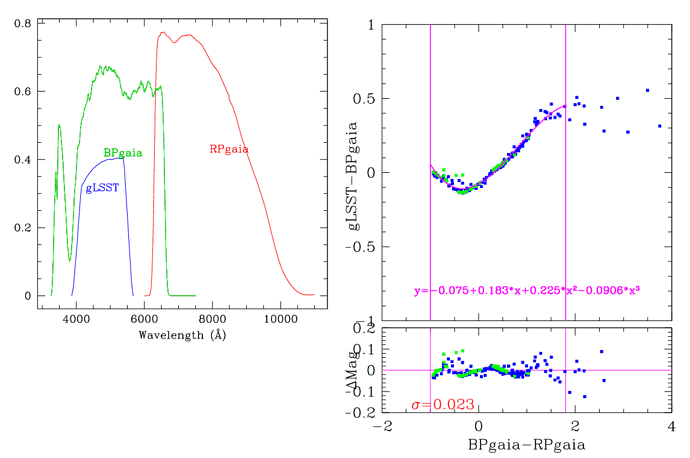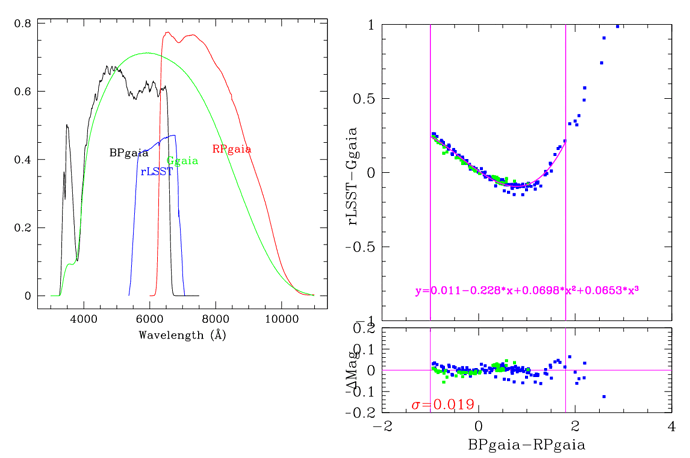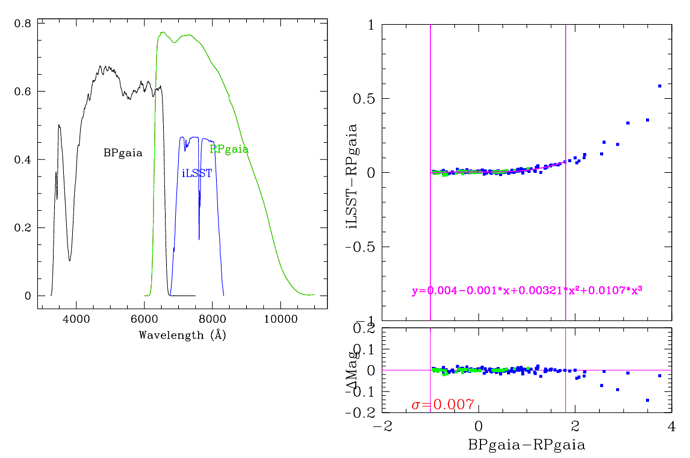Hi all,
I have a small catalogue of stars with Gaia DR3 information, and am wanting to convert their Gaia photometry into LSST photometry so that I can inject them into a DP0.2 image. I am struggling to find anything that outlines a conversion - is there any way to nicely map Gaia magnitudes to LSST bands?
Hi,
I’ve attached some figures with the transformations from Gaia G,BP,RP to LSST grizy. I multiplied the throughputs of the different filters by the PIckles and CALSPEC standard spectra to create synthetic photometry, and then fit a 3rd order polynomial. The left panel of the figures show the GAIA filter set and the LSST filter in question. The right panels show the transformation. The blue and green dots are represent Pickles and CALSPEC spectra respectively. The magenta line shows the polynomial fit. The bottom right panels shows the residuals about that fit.
Some caveats:
- the conversions are only valid in a restricted color range in BP-RP, as indicated by the vertical lines
- I haven’t checked extensively for the LSST filter set, but for the similar Pan-STARRS data set, the transformations are very sensitive to metalicity and extinction.
- I haven’t generated a transformation for u-band. Or rather I have generated a transformation, but it was very sketchy, and it shouldn’t be used.
Alternatively, you can use the GAIA spectra directly to generate photometry in any band. This will be more accurate, will have the metalicity and extinction built in, but only goes down to G=17 or so. There is a python package, gaiaxpy, that will do this for you.
Thanks for the good question @katesouthon, and thanks for the great reply @StephenGwyn. I was searching if there is an astropy or photutils function that could do the conversion, but I couldn’t find anything from an initial search. However, it looks like Stephen’s reply includes a detailed answer to your question.
This is not a perfect solution, since this is for transforming between the Gaia and DES DR2 photometric systems, but the DES DR2 grizY is similar to LSST grizy; so they may help.
Basically, inspired in part by work by Eli Rykoff and other work by Zeljko Ivezic, a set of transformation interpolations were created to convert between Gaia and DES DR2.
To use, one needs to use scipy.interpolate.interp1d python packages.
CSV files and QA plots for the transformations can be found from a link in the Overview section of the DES DR2 Photometric Transformations webpage.
I have a student who is looking at doing the same for LSST (and other near-future surveys and missions) using synthetic mags and colors, but that work is currently in progress.
PS: there are also some rendered Jupyter notebooks with this info at GitHub - DouglasLeeTucker/TransformEqns: Code for transforming between astronomical photometric equations .
Great, thank you all for your help!
Hi,
as far as GaiaXPy is concerned (GaiaXPy) there is also this more intuitive web tool based on it: GaiaPortal DR3 - SoS (you can upload up to 15000 Gaia Id). Synthetic magnitudes will be computed only for stars with continuous spectra (stars without spectra will be skipped). Spectra are available for 219 million sources, most of them brighter than G ~ 17.6 mag.




